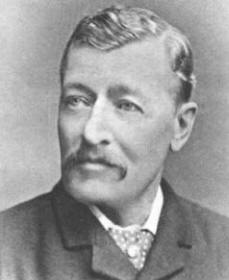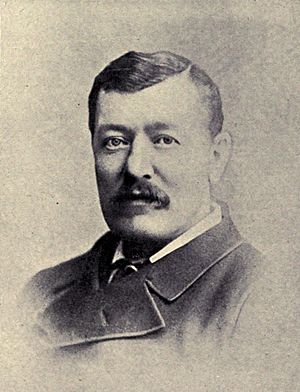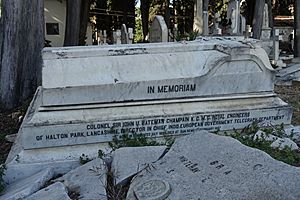John Underwood Bateman-Champain facts for kids
Quick facts for kids
Sir John Underwood Bateman-Champain
|
|
|---|---|

John Underwood Bateman-Champain in 1875
|
|
| Born | 22 July 1835 London |
| Died | 1 February 1887 (aged 51) Sanremo |
Colonel Sir John Underwood Bateman-Champain (born 22 July 1835 – died 1 February 1887) was a British army officer and engineer. He was born as John Champain. He played a very important part in setting up the first electric telegraph line from Britain all the way to India. This line went through the Persian Gulf. In 1870, he added the name Bateman to his own when he inherited the Halton Park estate in Lancashire.
Contents
Early Life and Learning
John Champain was born in London on July 22, 1835. His father was Colonel Agnew Champain. John went to Cheltenham College for his schooling. Later, he studied military drawing and fortifications at the Edinburgh Military Academy.
From 1851 to 1853, he attended the East India Company's Military Seminary at Addiscombe. He was a brilliant student, finishing at the very top of his class. He even received the special Pollock Medal. On June 11, 1853, he became a second lieutenant in the Bengal Engineers. He continued to rise through the ranks in the army.
Military Service in India
After more training in military engineering, Champain went to India in 1854. He became an assistant at the Thomason College of Civil Engineering. While he was there, the Indian Rebellion of 1857 began. This was a major uprising in India.
Champain quickly joined the fighting. He served as an adjutant (a kind of assistant officer) for the sappers and miners. He was involved in several battles, including those near the Hindun river and at Badli-ki-Serai. During the Siege of Delhi, Champain did a lot of engineering work. One of the siege batteries was even named after him because of his great efforts. He was hurt by grapeshot on September 13. But even while he was recovering, he volunteered to return to duty. He was present when the palace of Delhi was captured.
Champain led a group of Bengal sappers during marches and smaller battles. He commanded a large force of nearly two thousand men on a march from Agra to Fatehgarh. He also led the sappers during the siege of Lucknow. During this siege, he was praised for bravely holding an advanced post with other soldiers.
After Lucknow was captured, he helped build many fortified posts. He continued to pursue the rebels in other districts. He was thanked for his service in the action at Ballia. He received a medal for his bravery during these events.
Connecting the World with Telegraphs
After the rebellion ended, Champain worked as an engineer in public works. In 1862, he was chosen to go to Persia for government telegraph duty. At that time, there was no electric telegraph line connecting Britain to India. This made communication very difficult, especially during the rebellion. So, the government decided to build a line through the Persian Gulf.
Champain traveled to Bushehr and then to Teheran. There, he worked on agreements with the Persian government. By 1865, the telegraph line was mostly finished. When his colleague, Patrick Stewart, died that year, Champain took on more responsibility. He helped manage the Indo-European Government Telegraph department.
In 1866, he spent time in Turkey to make sure the Baghdad part of the line worked well. In 1867, he went to St. Petersburg in Russia. He negotiated for a special wire through Russia to connect to the Persian system. This trip helped build strong relationships with Russian telegraph officials.
In 1869, Champain was on his way to supervise the laying of a second telegraph cable. This cable would go from Bushehr to Jask. His ship, the SS Carnatic, was wrecked in the Red Sea. He nearly drowned but helped save lives and get help for others.
In 1870, he became the chief director of the Indo-European Government Telegraph Department. This was a very important job.
Helping During Famine
From 1870 to 1872, Persia suffered from a terrible famine. Champain cared deeply about this. He actively helped with a relief fund from London. He made sure that aid was given out in Persia by the telegraph staff. He was very happy with how well this was done.
International Telegraph Work
Champain was known for his good judgment and ability to work well with others. He could explain his ideas clearly. This made him very valuable at international telegraph conferences. He represented the Indian government at these meetings. He often traveled to different European cities to solve problems. He also made many trips to India, Turkey, Persia, and the Persian Gulf as part of his job.
In 1884, the Shah of Persia gave him a magnificent sword of honor. In 1885, Champain went to the Persian Gulf one last time. He oversaw the laying of a third cable between Bushehr and Jask. On his way home, he visited Delhi. There, he learned that he had been made a Knight Commander of the Order of St. Michael and St. George. This award was for his many years of service with the telegraph in India.
Other Interests
Champain was a member of the council for the Royal Geographical Society. He was also part of the Society of Telegraph Engineers, and he was its President in 1879.
He was also a very talented artist. In an exhibition in 1873, he won a gold medal for a painting of a Persian landscape. Many of the pictures in a book called Telegraph and Travel were based on his original sketches.
Later Life and Passing
Later in his life, Bateman-Champain had health problems like hay fever, asthma, and bronchitis. In January 1887, he was advised to leave England for a warmer climate. He spent three weeks in Cannes, France, and then went to Sanremo, Italy. He passed away there on February 1, 1887.
The Shah of Persia sent a special telegram to his family. The Shah expressed his deep sadness about Bateman-Champain's death. He said that Bateman-Champain had left "so many indelible memories in Persia." This was a very unusual and special message from the Shah.
Family Life
In 1865, Champain married Harriet Sophie Currie. She was the eldest daughter of Sir Frederick Currie. They had six sons: Arthur, Hugh, Claude, Francis, Philip and John. They also had two daughters, Mary Rosaline and Alice. Three of their sons joined the army, and one joined the navy. One son, John, became a church minister. Four of their sons (Hugh, Claude, Francis, and John) played cricket for Gloucestershire County Cricket Club. Harriet Sophie lived until August 14, 1905.



